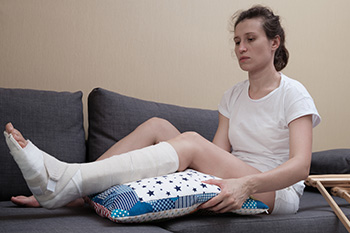Connect With Us
Blog
Items filtered by date: May 2024
Facts About Ankle Sprains and Skateboarding

Skateboarding is an exhilarating activity that combines skill, balance, and adrenaline. However, it also comes with its fair share of risks, including the potential for ankle injuries. Ankle sprains occur when the ligaments supporting the ankle joint are overstretched or torn, often due to sudden twists or impacts. In skateboarding, these injuries commonly occur when riders land awkwardly after performing tricks or navigating uneven terrain. Factors such as inadequate footwear, lack of protective gear, and insufficient warm-up routines can further increase the risk of ankle sprains. While ankle sprains are typically mild to moderate injuries, they can still cause pain, swelling, and limited mobility, potentially sidelining skaters for weeks or even months. Proper prevention and management strategies, including supportive footwear, using ankle braces or tape, and practicing proper technique, are essential for reducing the risk of ankle sprains while enjoying the thrills of skateboarding. If you have endured an ankle sprain, it is suggested that you contact a podiatrist who can offer both a treatment plan and additional prevention strategies.
Sports related foot and ankle injuries require proper treatment before players can go back to their regular routines. For more information, contact Magdy Issa, DPM of Charlotte Family Podiatry and Wound Center. Our doctor can provide the care you need to keep you pain-free and on your feet.
Sports Related Foot and Ankle Injuries
Foot and ankle injuries are a common occurrence when it comes to athletes of any sport. While many athletes dismiss the initial aches and pains, the truth is that ignoring potential foot and ankle injuries can lead to serious problems. As athletes continue to place pressure and strain the area further, a mild injury can turn into something as serious as a rupture and may lead to a permanent disability. There are many factors that contribute to sports related foot and ankle injuries, which include failure to warm up properly, not providing support or wearing bad footwear. Common injuries and conditions athletes face, including:
- Plantar Fasciitis
- Plantar Fasciosis
- Achilles Tendinitis
- Achilles Tendon Rupture
- Ankle Sprains
Sports related injuries are commonly treated using the RICE method. This includes rest, applying ice to the injured area, compression and elevating the ankle. More serious sprains and injuries may require surgery, which could include arthroscopic and reconstructive surgery. Rehabilitation and therapy may also be required in order to get any recovering athlete to become fully functional again. Any unusual aches and pains an athlete sustains must be evaluated by a licensed, reputable medical professional.
If you have any questions please feel free to contact our office located in Charlotte, NC . We offer the newest diagnostic and treatment technologies for all your foot and ankle needs.
Osteoporosis and Fractures of the Feet

Osteoporosis isn't just about fragile bones. It can impact balance, leading to falls and injuries beyond just the ankle and foot. Even without a specific foot or ankle injury, you might notice pain and swelling in these areas, signaling potential bone issues. Several factors contribute to the likelihood of developing osteoporosis, some within your control and others not. Age is a significant factor, with the risk rising notably for women over 50 and men over 70. Women are more predisposed to osteoporosis and genetics can further increase the risk. While you can't change your age, gender, or genetics, certain lifestyle factors help to reduce your risk. A balanced diet rich in essential nutrients helps maintain bone strength. Hormonal changes, such as low estrogen levels in women and testosterone in men, can affect bone mass and should be monitored. Excessive alcohol consumption and smoking can weaken bones and overall health. Regular exercise, especially weight-bearing activities, can strengthen bones and improve bone density. Even moderate daily exercise, like taking a walk, can make a significant difference in bone health. By understanding these factors and making informed choices, you can take proactive steps to protect your bone health and minimize the risk of osteoporosis-related complications in your feet. If you are experiencing foot or ankle pain that may be connected to osteoporosis, it is suggested that you make an appointment with a podiatrist for an exam and treatment options.
A broken foot requires immediate medical attention and treatment. If you need your feet checked, contact Magdy Issa, DPM from Charlotte Family Podiatry and Wound Center. Our doctor can provide the care you need to keep you pain-free and on your feet.
Broken Foot Causes, Symptoms, and Treatment
A broken foot is caused by one of the bones in the foot typically breaking when bended, crushed, or stretched beyond its natural capabilities. Usually the location of the fracture indicates how the break occurred, whether it was through an object, fall, or any other type of injury.
Common Symptoms of Broken Feet:
- Bruising
- Pain
- Redness
- Swelling
- Blue in color
- Numbness
- Cold
- Misshapen
- Cuts
- Deformities
Those that suspect they have a broken foot shoot seek urgent medical attention where a medical professional could diagnose the severity.
Treatment for broken bones varies depending on the cause, severity and location. Some will require the use of splints, casts or crutches while others could even involve surgery to repair the broken bones. Personal care includes the use of ice and keeping the foot stabilized and elevated.
If you have any questions please feel free to contact our office located in Charlotte, NC . We offer the newest diagnostic and treatment technologies for all your foot and ankle needs.
